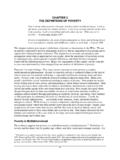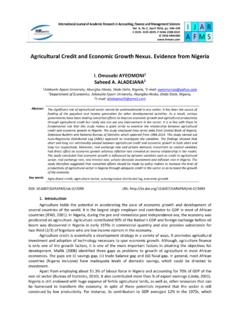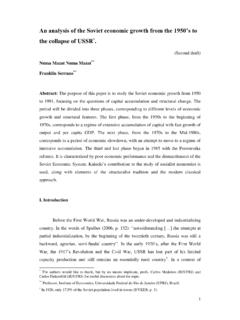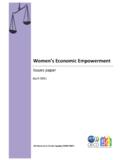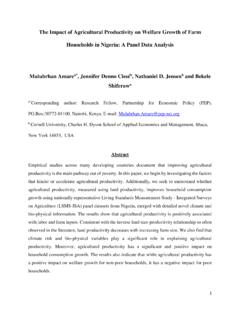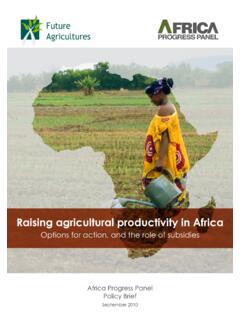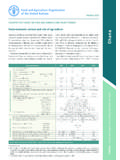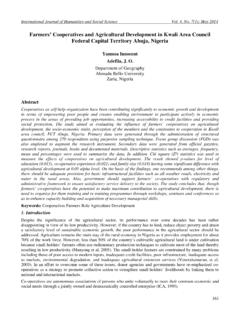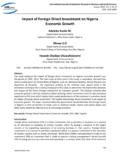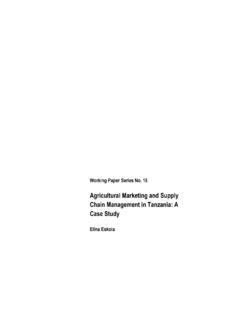Transcription of Rural Infrastructure and Agricultural Development - World …
1 Rural Infrastructure and Agricultural Development Per Pinstrup-Andersen The Babcock Professor of Food, Nutrition and Public Policy Cornell University And Satoru Shimokawa Candidate, Applied Economics and Management Cornell University Paper prepared for presentation at the Annual Bank Conference on Development Economics, Tokyo, Japan, May 29-30, 2006. 1. Abstract Agricultural Development is essential for economic growth , Rural Development , and poverty alleviation in low-income developing countries. Productivity increase in agriculture is an effective driver of economic growth and poverty reduction both within and outside Agricultural sectors. Such productivity increase depends on good Rural Infrastructure , well functioning domestic markets, appropriate institutions, and access to appropriate technology.
2 While the state of Rural Infrastructure varies widely among developing countries, most lower-income developing countries suffer severe Rural Infrastructure deficiencies. Deficiencies in transportation, energy, telecommunication, and related Infrastructure translate into poorly functioning domestic markets with little spatial and temporal integration, low price transmission, and weak international competitiveness. In spite of the well documented importance of Rural Infrastructure to promote growth and poverty alleviation, high economic rates of return to investments in Rural Infrastructure , and significant deficiencies of Rural Infrastructure in most developing countries, neither national governments nor international aid agencies seem to prioritize investments in the construction of new Infrastructure and maintenance of existing Infrastructure .
3 Much of the required investment is of a public goods nature and thus most of the Infrastructure investments must come from public sources, while public-private partnership should be pursued when appropriate. Failure to accelerate investments in Rural Infrastructure will make a mockery of efforts to achieve the Millennium Development Goals in poor developing countries while at the same time severely limit opportunities for these countries to benefit from trade liberalization, international capital markets, and other potential benefits offered by globalization. 2. Agricultural Development is Essential for economic growth , Rural Development , and Poverty Alleviation Agriculture constitutes the core of the economy of most low-income developing countries. In heavily indebted poor countries, the Agricultural sector generated 33 percent of the Gross Domestic Product (GDP) and 52 percent of total merchandise exports in 2002.
4 The Agricultural sector accounted for about 60 percent of employment in low-income countries in 1995. Even in East Asia and the Pacific which have experienced rapid economic growth the Agricultural sector accounted for 46 percent of employment, generated 16 percent of GDP, and was responsible for 10 percent of total merchandise exports in Such economic dominance of agriculture demonstrates the importance of Agricultural Development for economic growth and poverty alleviation in developing countries. Moreover, although the relative contribution of agriculture to the overall economic growth decreases as an economy develops, Agricultural Development provides a crucial foundation for economic growth in both Agricultural and non- Agricultural sectors. Virtually every high- and middle-income country, with the exception of city nations such as Singapore and Dubai, has gone through a period of Development when Agricultural growth was essential to foster general economic growth and poverty alleviation.
5 On the other hand, low-income countries with a stagnant agriculture usually have a stagnant economy. Moreover, endeavors to jump directly to modern industrialization without paying enough attention to Agricultural Development in the early stages of Development have tended to result in a failure in economic growth and poverty alleviation (Gulati, Fan and Dalafi 2005; Rottso and Torvik 2003). Agriculture as the Driver of economic growth Although early Development literature considered the role of agriculture in economic Development to be a supportive one for industrial sectors such as ensuring a supply of cheap food for workers in industrial sectors (see, for example, Lewis 1954), a more active role of agriculture as 1. Data from World Development Indicators ( World Bank 2005) for several years.
6 3. the driving force of overall economic growth has been recognized and emphasized since the 1960s (see, for example, Mellor 1966; Schultz 1964; Johnston and Mellor 1961). A large share of subsistence and semi-subsistence agriculture has been transformed through the adoption of new technology, investments in Rural Infrastructure and markets, and the design and implementation of appropriate policies. This transformation leads to an increase in productivity of land and labor and results in increasing incomes for farmers and farm workers and enhanced purchasing power for consumers. Low food prices achieved by reduced unit-costs of production contribute to lower wages in non- Agricultural sectors and thus facilitate industrial growth . Furthermore, Agricultural growth contributes to economic activity in input, processing, distribution, and storage industries, generating multiplier effects beyond agriculture.
7 In addition, increasing Agricultural incomes induce a rise in demand for goods and services produced in other sectors (Hazell and R ell 1983). A number of empirical studies ( , Hazell and R ell 1983; Haggblade, Hammer and Hazell 1991; Delgado and others 1998; Fan, Hazell and Thorat 2000; and Fan, Zhang and Zhang 2002). conclude that the multiplier effects of Agricultural growth is usually greater than two. The size of the multiplier effects varies spatially and over time, reflecting differences in consumption, investment, and saving patterns. In general, the multiplier effects tend to be high when Agricultural growth is driven by broad-based productivity increases in a Rural economy dominated by small farms, as in much of Asia (Mellor 1976). Small- to medium-sized farm households typically have more favorable expenditure patterns for promoting growth of the local nonfarm economy, including Rural towns, since they spend higher shares of income on Rural nontraded goods and services, which are also generally more labor intensive (Hazell and R ell 1983).
8 In a study of four African countries, Delgado and others (1998) estimated the income multipliers to be around , meaning that each additional dollar of income from agriculture generates about $ of economic growth in the economy as a whole. In the more open economies of Asia, where rice was more tradable than most African staple foods and local prices more easily 4. reflected border prices, the multiplier effects were close to 2 in the early stages of Agricultural modernization when productivity gains were the fastest. In addition, Gollin, Parente, and Rogerson (2002), using data for 62 developing countries during 1960-1990, find that Agricultural growth , non- Agricultural growth , and sectoral labor shifts explain 54 %, 17 %, and 29 % of the growth of GDP. per worker, respectively.
9 Agricultural Development and Pro-poor growth Agricultural Development has a significant potential to contribute to nation-wide poverty reduction through direct effects on farm incomes and employment and indirect effects on overall economic growth , as well as its impact on food prices. A number of studies have found a positive correlation between Agricultural growth and poverty alleviation (see Byerlee, Diao, and Jackson 2005 for a more detailed review). It is empirically shown that poor people tend to benefit more from economic growth originating in Agricultural sectors than from that originating in industrial or service sectors (Ravallion and Datt 1996; Ravallion and Chen 2004; and Timmer 2002, 2005). In addition, Ravallion and Datt (1996), using data for India over 1951-1990, show that Rural growth through Agricultural Development reduces poverty not only in Rural areas but also in urban areas and hence has a significant and positive effect on national poverty reduction.
10 Several studies have found that the elasticity of poverty reduction with respect to Agricultural productivity is significant, positive and higher than the elasticity with respect to other sectors'. productivity, especially in the early stages of Development . For example, Thirtle, Lin, and Piesse (2003) estimate the elasticity of the reduction in the number of people living on less than $1 per day with respect to Agricultural productivity growth using data from 59 countries over 1985-1995. According to their estimates, the elasticity was and (73% and 67% of the total impact of increases in per capita GDP) in Africa and Asia, respectively. Datt and Ravallion (1998) estimated the elasticity of the reduction in three FGT-type poverty indicators (Headcount (HC), Poverty Gap (PG), and Squared Poverty Gap (SPG)) with respect to Agricultural value added per hectare using 5.









